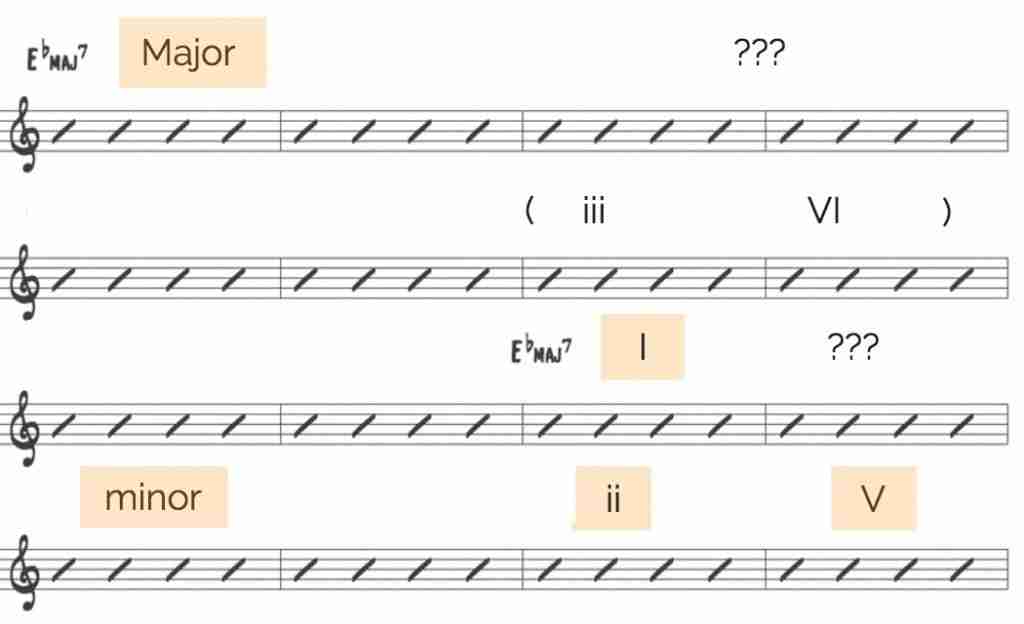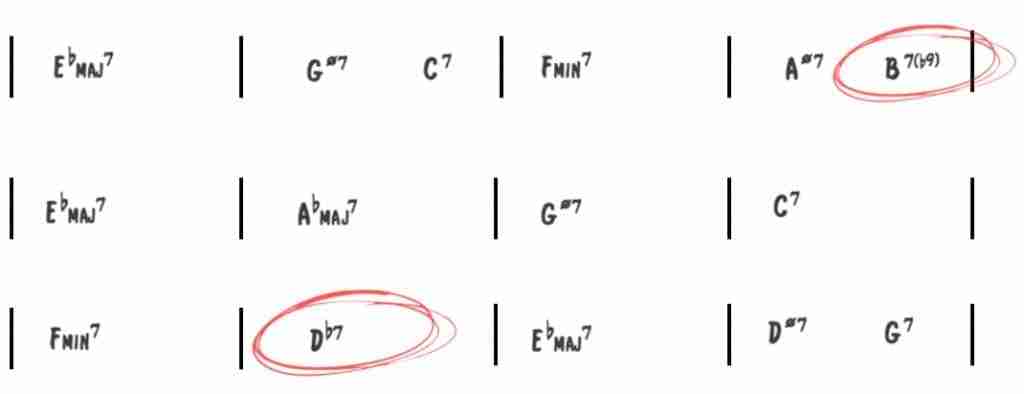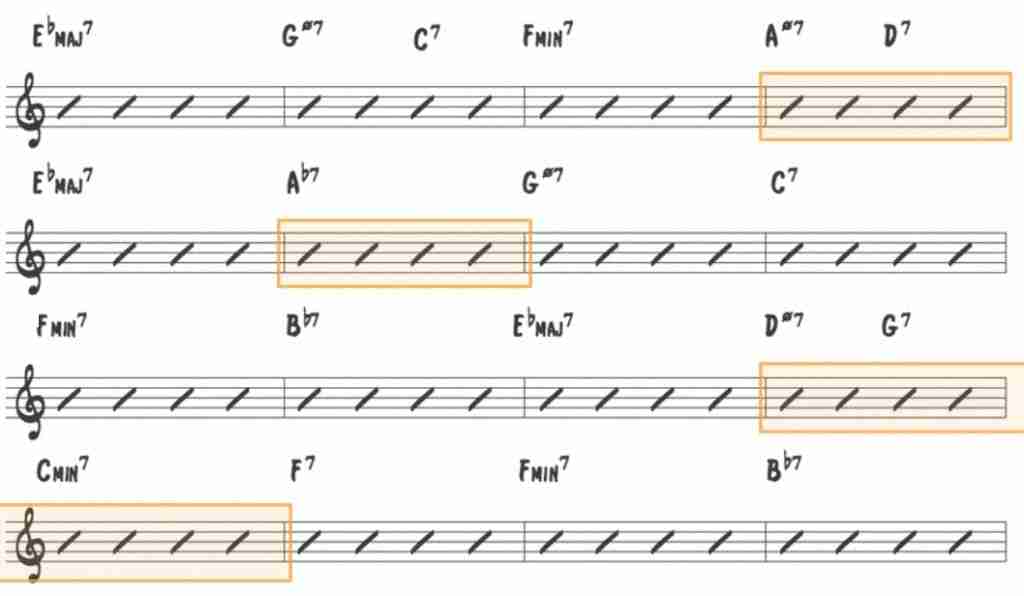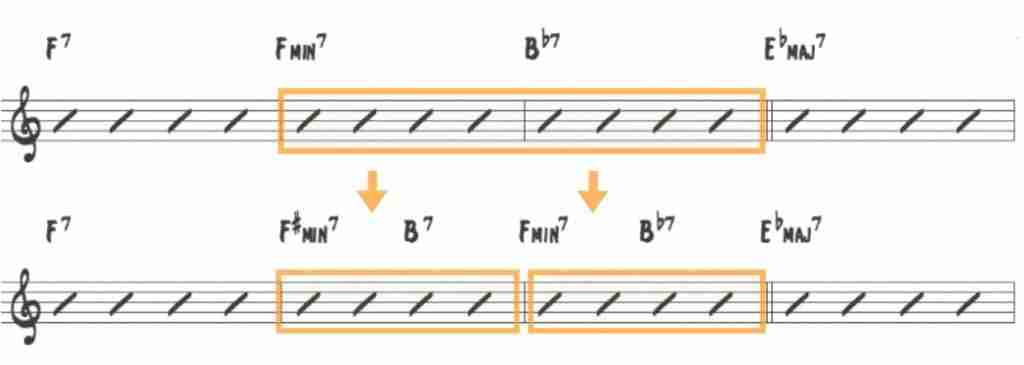You’ve got a list of tunes that you’re excited to learn. Song titles scribbled on a piece of paper, lead sheets saved on your phone, and videos of your favorite players killing the changes. However, you’ve been down this road before…
After a few days, your cherished goal of learning more tunes slowly morphs into a “musical chore” that you force yourself through in the practice room, checking off songs one by one. The result? A bunch of uninspired tunes that sound like memorized notes and chords.
But shouldn’t the process of learning jazz standards be more than a trivial memorization exercise…
If you’re like me, you’re ready for a fresh start with the jazz repertoire. No more long lists with hundreds of tunes, staring at pages in the realbook, or fumbling through another set of chord symbols at jam sessions and gigs…
Instead of the same old approach to repertoire, we’re going to show you a process for learning tunes where you’ll actually remember the melody and harmony, and be able to create music.
“Get away from the production-line mentality in learning jazz standards. Quickly memorizing notes and chord symbols and moving on. You’ve got to live with a tune for a while, to love it even, before you can truly tell a story with it.”
It’s one thing for your instructors to say “Just learn the tune from the recording!” and another thing for you to actually close the fakebook and do it.
That’s why in today’s lesson we’ll dig into the most effective way to learn the melody, memorize the chord progression, and build a foundation for creating a musical solo with the jazz repertoire.
A aural process for learning standards that isn’t making lists of songs and memorizing chord symbols. And you might be surprised to learn that it’s easier than you think.
To see what I mean, let’s take a look at the jazz standard It Could Happen To You…
I. Start with the melody
With any tune that you want to learn, the best place to begin is with the melody. Specifically, with focused listening to a recording, rather than reading notes from a page.
Let’s check out the well-known Miles Davis version of the tune from the album Relaxin’ with the Miles Davis Quintet:
Instead of running straight to your instrument and trying to pick out random notes, start the learning process by singing the melody along with the recording. This will immediately ingrain the sound of these notes and intervals in your ear.
If you’ve struggled with memorizing tunes in the past or have had trouble remembering melodic lines while performing, singing is an effective path to overcoming these obstacles.
Transition from a visual or theory approach to memorizing the melody [“OK start on a Bb, then C to Db …”] to focusing on the sound of the notes and intervals.
Sure, it’ll take a little more time learning the melody based on what you’re hearing as opposed to what you’re seeing, but remember, you don’t have to learn the entire thing at once.
The secret to this lies in breaking down the melody into individual phrases and ingraining them one by one. Let’s take the first four bars of It Could Happen To You:
As you close your eyes and listen, focus on the intervals and contour of the phrase. Don’t worry about the chords yet – you’ll have plenty of time for that later!
You’ll know you have the line in your ear when you can sing it without the aid of the recording. Don’t move on until you get each phrase to this point.
Next, isolate the intervals that make the phrase unique. For example, in the opening of the melody you have scalar motion up a minor 3rd and then an ascending perfect 5th:
Ingraining the structure of the line in this manner, instead of note names or fingerings, will allow you to play it from any starting note.
The one skill that will make this process of learning tunes by ear much easier is the ability to aurally identify intervals and chord tones. Immediately recognizing the sound of a Major 3rd, a perfect 4th, a 6th, a minor 7th, etc.
This is where some ear training practice comes in handy. Remember, the better your ears are, the quicker this process will go.
“Don’t rely on just one recording to learn a tune – listen to as many versions as you can! Not only will you find different interpretations of the melody, you’ll find different keys, different chords, and different approaches to soloing.”
As you probably noticed, Miles doesn’t exactly stick to the written melody note for note, so it’s a good idea to listen to multiple recordings to find the “definitive” version you’re likely to encounter on the bandstand.
A quick search online will give you dozens of results. Let’s check out how Kenny Dorham plays the tune:
Listen to how he interprets the melody in the last 8 bars at [0:51 sec]. Again, focus on the shape and intervallic content of the phrase and sing it:
In the first part of this phrase, the notable part of the melody is the enclosure of the Eb and and ascending perfect 5th:
And in the last phrase it’s the ascending minor 7th:
Continue this process with each phrase until you have the entire melody ingrained. Singing, playing, and analyzing the structure of each line along the way. This might seem tedious, but the process will go faster than you think!
Not only will you be able to ingrain the melody without relying on a hazy recollection of a lead sheet, you’ll be able to perform it in other keys without having to transpose notes names, fingerings, or even scales.
Don’t forget about the lyrics!
Many of the tunes in the jazz repertoire come from musicals or the films of the 1930’s and 40’s. And It Could Happen To You is no exception…
Along with the melody and harmony, these songs also have a story to tell, and the place you’ll find it are within the lyrics of the song.
Tap into this story as you learn the tune and eventually perform it. Find a vocal version of each standard and study the lyrics. Check out vocalists like Ella Fitzgerald, Frank Sinatra, or Chet Baker…
“Hide your heart from sight, Lock your dreams at night, It could happen to you…Don’t count stars or you might stumble, Someone drops a sigh and down you tumble…”
Rather than another set of boring ii-V’s to memorize, think about how will these lyrics affect the way you interpret the tune or phrase the melody.
II. Figure out the chords
With the melody in your ear, it’s time to tackle the harmony of the tune.
As you listen back to the recording, this time you’re going to focus on the “big picture” items about the chord progression:
- Is the tune in major, minor, or another harmony altogether?
- What key is it in?
- Does the tune start and end on the root (I chord)?
- What is the form/is there a bridge?
- Are there any spots that sound like ii-V’s or other common progressions?
Start with small sections of the tune, identifying chord quality and chord relationships along the way. It helps to find a recording where the orchestration is simple so you can clearly hear the melody, chords, and bass line.
A great example is Nat King Cole’s recording of It Could Happen to You from his album Penthouse Serenade:
As you listen, try to identify these “big picture” components of the harmony…
Depending on your ears, you might be able to determine it’s in major and with the help of a keyboard nearby, you can probably figure out that it’s in Eb. You might also be able to recognize some places where there’s a ii-V progression or a turnaround:
However, there are also going to be some spots where you just can’t figure out what the chords are. In this case, try focusing on what the bass is playing.
“If you find yourself lost with the chord progression or have trouble with a particular chord, transcribe what the bass player is doing.”
Here the goal is to listen to the root movement. Put on some headphones, slow down the recording, and focus on the bass notes:
If you combine these bass notes with the chord quality you’re hearing (major, minor, V7, etc.) it will give you a good idea of the progression:
*It’s also important to realize that the bass player is not always playing the root on the downbeat of each chord.
In the same way that you should learn the melody from multiple recordings, figure out the chord progression by listening to more than one source. They are not all the same…
If we go back to the Miles Davis version, check out what Paul Chambers is doing over the first four bars:
Rather than outlining the standard I-iii-VI-ii progression, he ascends by half-step from the first Eb. With these bass notes as the roots of the chord, you can infer the following progression:
This works because Eº7 has the same harmonic structure as Gø to C7b9:
So you can think of either chord as you improvise in the second bar, adding another harmonic approach for your solos. And the same is true in the fourth bar for F#º and Aø to D7b9.
If you’re still stuck, use the melody for clues in figuring out the chord progression. Listen slowly to the melodic line to determine what chord tones are being utilized or if the phrase is implying a harmonic progression.
Wait, why not just use a fake book??
As you’re reading this, you’re probably thinking to yourself, “Hey, why not just grab a fakebook and be done with it??”
Why should you go through all the work of finding a recording, listening to it on repeat, getting out your instrument, and slowly working through the melody and chords?
I mean, a quick search online or a glance at a fakebook will immediately give you the following progression:
This may sound like an obvious choice, however the problem is that these chords are not exactly right…the B7 and Db7 chords are substitutions for the original changes.
If you tried to learn the tune or improvise over it without ever listening to it, you’d notice that something sounds off, that the written chords don’t make sense. By memorizing this progression with your eyes, you’re missing the underlying structure of the harmony.
Remember, the version in the real book isn’t an authority that’s set in stone. Be sure to listen to every tune that you are learning!
“Don’t rely solely on a fakebook to figure out the chords. Not only will those visual symbols leave out your ears and trap you into a mental approach to the harmony, they might even be wrong!”
III. What makes these chords unique?
Now that you’ve learned the chord progression, you need to figure out how you’re going to remember tit when you are at a jam session or performing for an audience…
What will help you remember the chords when you play this tune a week, a month, or even year a from now? What makes this progression stand out from every other standard that you’ll learn?
Every standard has a spot or twist in the chord progression that makes it unique. Kinda like road signs to look out for that will help you remember and distinguish this tune from the other standards that you are learning.
To find these areas in each tune, you’ll need to start by identifying the individual chords of the chord progression in roman numerals:
If Eb major is the I chord of the tune, determine how each successive chord relates to the home key.
This will get you out of the mindset of learning chords in one key, focusing instead on the function of the chord. Now look at the progression in it’s entirety. In this tune, there are three chord relationships that stick out:
Isolate these 3 spots in the chord progression, analyze them, and work them out individually…
The iiø – V7 of the iii chord
The I – iii – VI – ii progression found at the beginning of It Could Happen to You is a common occurrence in any standard, but the thing that makes this tune unique is that it goes into a iiø V7 of the iii (G-7). However, instead of going to G minor, the progression resolves to EbMajor7, which is essentially the same chord.
Isolate the first four bars and practice moving to the ii (F minor) chord to this minor ii-V:
Movement to the IV chord
Another spot to lay for in the chord progression is the movement to the IV chord in the sixth bar:
The ii – V to the relative minor
Finally, isolate the 12th bar where the progression moves to the relative minor, a ii-V to C minor:
If you use your ears and remember these key spots, you pretty much have the chord progression to It Could Happen To You down.
You can test your skills by visualizing the tune in other keys. For instance, try to visualize the chord progression in the key of F:
III. Ingrain the melody and chords in your ear
So you have the melody and chords figured out, time to start soloing…but wait, you’re not done yet!
Once you have the melody and harmony of the tune down, it’s time to put the two together and ingrain them. So in performance, you can focus on creating a solo rather that thinking about the chords and melody.
Begin by understanding how the melody relates to the underlying chords. Specifically, what chord tones is the melody using on each chord?
In this case, the melody uses the 5th as a prominent chord tone in the melody:
Ingrain the sound of each melodic note in your ear on each chord. A great exercise for this is to play the chords on the piano, adding the melody notes on top. Listen to how each note fits into the underlying harmony.
Your goal here is to form a mental and aural picture of the tune that you won’t forget.
“Aim to have a mental roadmap of the tune in your mind – seeing and hearing the entire progression from beginning to end.”
One of the most effective things you can do after you’ve learned the melody and changes is to work through the sound of each chord and the resulting progression on your instrument – without accompaniment.
A great example of this is the Sonny Rollins recording of the tune from the album The Sound of Sonny:
Don’t worry about the time or tempo! Take your time on each chord and slowly create melodies, working out how to connect one sound to the next.
IV. Improvise: Take ideas from the solos
Once you have both the melody and chord progression ingrained, it’s time to start thinking about improvising.
The best place to start looking for ideas is the solos on the recordings from which you learned the melody.
You don’t have to transcribe the entire solo, instead take the phrases that you like and figure out why they work. Look specifically for how these players are navigating the unique chord movement in this tune:
- I – iii – VI – ii in the opening measures
- The Paul Chambers half-step movement
- The minor ii-V in the fourth bar
- The movement to the relative minor
Let’s take the Paul Chambers movement over the first four bars for instance. Transcribe how Miles navigates this progression ascending by half-steps:
What ideas or techniques can you steal and incorporate into your own solos over the tune?
A more modern approach to the tune can be found on Nicholas Payton’s record From This Moment:
Check out Nicholas Payton’s eight bar intro to the tune:
Study his melodic approach to the I – VI – ii – V progression and find devices that you can apply to these spots in the progression.
Another thing to note about this recording is how they utilize chromatic ii-V’s. Instead of a traditional two bar ii-V (F-7 to Bb7) they play a one bar chromatic ii-V a half-step up (F#- B7) that moves back down to a bar of the original ii-V:
Finally, let’s take a listen to Chet Baker’s scat singing solo over the progression (in the key of G):
Chet’s solo is a great model for playing over the chord progression in a melodic way. Not only playing over individual chords, but creating phrases that stretch over the entire progression.
These are just a few ideas to get started with and inspire your own approach to creating a solo.
It all starts with one tune
I know, this might seem like a lot of work to go through to learn only one tune…
Especially when you envision yourself being able to one day walk into a jam session with 50 or even 100 tunes under your belt.
But think about the big picture. If your goal is to build a repertoire of tunes that you can confidently and musically play over, you need to ingrain this information at a deeper level.
Why just memorize information, notes and chord symbols, when you can be building skills and developing your musicality?
Remember, the goal of learning tunes isn’t to see how many you can memorize or to pass a test…it’s so that one day you’ll perform them in front of an audience. To eventually make music with other people and tell your own musical story.
The skills you gain from learning this tune will help you with every other standard that you learn. You’re not just learning It Could Happen to You, you’re learning the fundamentals of harmony, training your ears, and defining your musical style.
At the end of the day, being able to play one tune well, with musicality and mastery of the melody and harmony, is better than quickly memorizing thirty tunes and fumbling through the chords in a solo.
Give it a try with this tune and you’ll see what I mean…
































